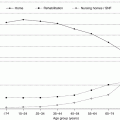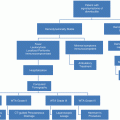Fig. 26.1
Distribution of pelvic fracture cases and controls by age and gender [10] (Reprinted, with permission, from Oxford University Press)
A 2009 retrospective review found the mechanism of injury associated with pelvic fracture in patients younger than 65 years was motor vehicle collision (MVC) in 86.7 % and fall in 13.3 %; however, in those over the age of 65 years, nearly 30 % had a fall as the mechanism of injury [12]. Another study of pelvic fractures in patients over the age of 65 years found 83 % suffered injury from low-energy trauma as a result of fall from standing or transferring [13]. These fractures continue to present treatment dilemmas and can be a major source of morbidity and mortality.
Risk Factors
The older population is disproportionally impacted by falls. Patients older than 65 years represent 43 % of those injured by falls. Ground-level falls are traditionally thought to be a low-impact mechanism associated with inconsequential injuries. However, age greater than 55 years is independently predictive of significant injury in patients with low-energy mechanisms of injury [14]. Ground-level falls are the immediate cause of injury in nearly 80 % of elder patients with a pelvic fracture. Since falls are a significant mechanism for the disruption of the pelvic ring, it stands to reason that the risk factors for falls (Table 26.1) would be similar for pelvic fracture. Osteoporosis is an important comorbidity affecting elderly patients. It is estimated that 64 % of fractured pelvis are osteoporotic and in patients over the age of 60 years, the incidence increases to 94 % [15]. Seely et al. in a prospective cohort study demonstrated that pelvic fractures among others were related to reduced bone mass [16]. Fractures of the pelvic bones represent 7 % of all osteoporosis-related fractures in people 50 years or older in the United States. Several other associations have been suggested (Table 26.2) [10].
Table 26.1
Contributing factors to injuries in elderly patients
Chronic medical condition | Environmental factors | Acute medical conditions | Other |
|---|---|---|---|
Osteoarthritis | Rugs | Syncope | Older age |
Osteoporosis | Lighting | Dysrhythmias | Female gender |
CVA | Stairs | CVA, TIA | Alcohol and drug use |
Ischemic heart disease | Bathtubs/showers | Acute MI | Elder abuse |
Anemia | Footwear | Seizure | |
DM | Uneven ground | Acute renal failure | |
HTN | Weather | Infection | |
Gait and balance disturbances | Walking aids | Hypoglycemia | |
Visual impairment | Acute fractures | AAA | |
Depression | Self-inflicted injury | New medications | |
Polypharmacy | Dehydration | ||
Parkinson’s disease | |||
Dementia |
Table 26.2
Associations with pelvic fracture in the elderly
Potential risk factors for pelvic fracture |
History of previous fracture after age of 45 yearsa |
Maternal history of hip fracturea |
Cigarette smokinga |
History of hysterectomya |
History of seizurea |
History of Parkinson’s disease |
Caucasian femalea |
Use of assistive devices |
Low body weighta |
Need for assistance with ADLa |
History of stroke |
Wearing corrective lenses |
Frequent use of hearing aid |
Increased height |
Left handedness |
Use of walking aids |
Anatomy
The pelvis is composed of five bones, the ilium, the ischium, the pubis, the sacrum, and coccyx. The bones are connected to each other by several strong ligaments that resist transverse and longitudinal rotational forces to maintain pelvic stability. In general high energy is required to disrupt these strong bones and ligaments. However, in the elderly complex fracture can occur through low-energy impacts due to the presence of osteoporosis. The lumbosacral and coccygeal nerve plexuses are anterior to the sacrum and coccyx. These nerves arise from the T12 to S4 spinal nerves. Somatic and autonomic nerve injury is a real threat with injury to the pelvis. A thin-walled venous plexus is intimately attached to the sacrum and pubic bones. A rich blood supply arising from the iliac arteries supplies the soft tissues of the pelvis. These structures are all at risk for injury when the bones and ligaments in the region are injured. When the skin and superficial fascia are degloved as result with a closed shearing injury between the skin and superficial fascia, a Morel-Lavallee injury is produced [17]. In the elderly patient these injuries can result in enormous blood loss compared to a younger patient where the bleeding is self limiting. With the loss of tissue elasticity and the loss of blood vessel compliance, this kind of injury can result in ongoing hemorrhage leading to hemodynamic instability. The pelvis contains the lower genitourinary viscera and injury to the pelvis may also result in injury to these organs by proximity.
Classification
Several classification systems to describe pelvic fractures exist. Initially fractures are assessed for stability. Stable fractures are characterized by single fractures of the pelvic ring, pure acetabular factures, straddle fractures of the pubic rami, and chip fractures or avulsion factures. Unstable fractures, on the other hand involve disruption of the pelvic rim in more than one place, such as the posterior pelvis, sacrum and sacroiliac complex. This includes the so-called Malgaigne (fractures of both rami and a posterior fracture of the sacroiliac complex) and open-book fractures (diastasis of the symphysis pubis and external rotation of one or both iliac bones). Arguably the most widely used classification system is the Young and Burgess system (see Table 26.3) [18]. Such classifications guide surgical intervention for fixation of these fractures. They are dependent on knowledge of direction of injury force in addition to the anatomic site of injury. Many investigators have tried to correlate injury classification with likelihood of associated injury and transfusion needs with variable results. Many studies of patients with pelvic fracture conclude that patients with disrupted ligaments and high-grade fracture patterns are at highest risk of arterial bleeding. The patterns identified include APC II, APC III, LC III, and vertical shear (VS). Angiographic embolization has been noted to be required more frequently in patients with APC, VS, or combined fracture patterns. It was required in 20 % of the former, while necessary in only 2 % of patients with lateral compression injuries (Table 26.3) [19]. A 2002 study of 234 patients with pelvic fracture found that lateral compression mechanisms were most common in patients over the age of 55 years, with 80 % classified as LC1. Despite this, patients with lateral compression fractures that were over the age of 55 were 3.9 times as likely to require blood transfusion as those younger than 55 [20]. Metz et al. found older patients with stable fracture patterns demonstrated more vascular injury than would be predicted. The average age of patients in the older group was 67 years. They postulated that these patients had decreased vascular compliance making them more vulnerable to shearing injury to blood vessels [21].
Table 26.3
Young and Burgess pelvic fracture classification
Fracture type | Common characteristic | Differentiating characteristic | Avg EBL 24 h |
|---|---|---|---|
Lateral compression (LC) | Anterior transverse fracture of the pubic rami | 2.4 | |
Type 1 | Anterior transverse fracture of the pubic rami | Sacral compression on side of impact | 2.8 |
Type II | Anterior transverse fracture of the pubic rami | Crescent (iliac wing) fx | |
Type III | Anterior transverse fracture of the pubic rami | Contralateral open-book (anterior posterior compression) APC injury | 5.7 |
Anterior posterior compression (APC) | Symphyseal diastasis | ||
Type I | Symphyseal diastasis | Slight widening of pubic symphysis and/or sacroiliac (SI) joint; stretched but intact anterior and posterior ligaments | |
Type II | Symphyseal diastasis or anterior vertical fx | Widened (SI) joint; disrupted anterior ligaments; intact posterior ligaments | 6.4 |
Type III | Symphyseal diastasis | Complete hemipelvis separation, but no vertical displacement; complete SI joint disruption; complete anterior and posterior ligament disruption | 20.5 |
VS | Symphyseal diastasis or anterior vertical fx | Vertical displacement anteriorly and posteriorly, usually through SI joint, occasionally through iliac wing and/or sacrum | 7.8 |
Combined mechanism | Anterior and/or posterior, vertical and/or transverse components | Combination of other injury patters LC/VS or LC/APC | 7.1 |
Diagnostics
Patients are initially assessed clinically. The hallmark of injury is pain. A non-tender pelvis in a neurologically normal patient is unlikely to be fractured. Palpation should include the symphysis pubis, the iliac crest, and sacroiliac region. Patients with severe fractures may have other findings on physical examination such as hematoma, abrasions, and lacerations (see Table 26.4). Leg length discrepancy may be seen and rotational or vertical instability may be elicited on physical examination. Bimanual compression and distraction of the iliac wings can discern vertical or rotational instability but can also recreate bleeding from a stabilized hematoma so should be performed with care and only once when an abnormality is elicited.
Table 26.4




Physical findings seen in severe pelvic injury
Stay updated, free articles. Join our Telegram channel

Full access? Get Clinical Tree







